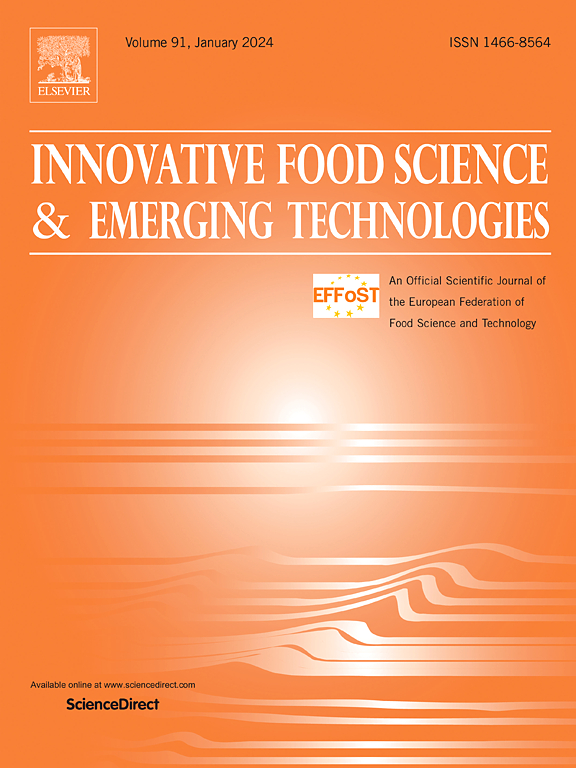GABA- and riboflavin-enriched soy and oat beverages using selected lactic acid bacteria
IF 6.3
1区 农林科学
Q1 FOOD SCIENCE & TECHNOLOGY
Innovative Food Science & Emerging Technologies
Pub Date : 2025-07-04
DOI:10.1016/j.ifset.2025.104108
引用次数: 0
Abstract
Gamma-aminobutyric acid (GABA) and riboflavin have received significant attention as attractive bioactive compounds with attributed health-promoting properties, including antidepressant and neuroprotective effects. This study aimed to develop soy and oat beverages enriched in GABA and riboflavin through fermentation with specific lactic acid bacteria (LAB) strains. The screening of LAB producers of bioactive compounds concluded with the identification of new riboflavin-producing LAB strains, including for the first time the species Fructobacillus tropaeoli. Nevertheless, since spontaneous strains resistant to roseoflavin showed the ability to overproduce riboflavin, four mutants of Lactiplantibacillus plantarum and Limosilactobacillus fermentum were selected. Additionally, four strains belonging to the species L. plantarum and Lactococcus lactis were selected as high GABA producers. Soy and oat beverages supplemented with 0.2 % monosodium glutamate, as precursor of GABA, and inoculated with the selected single strains were fermented for 48 h at their optimal temperature (30 °C or 37 °C). Riboflavin and GABA production, as well as glutamate utilization, were determined after fermentation, leading to the selection of the riboflavin-overproducing mutant L. plantarum Al03R3 and GABA-producing L. lactis INIA Z174 for co-culture. Fermentation with this combination of strains produced fermented soy and oat beverages enriched with both GABA and riboflavin. Notably, the oat beverage exhibited particularly high yields, reaching 0.98 g/L of GABA and 4.72 mg/L of riboflavin, making it a suitable functional drink for delivering these health-promoting compounds.
利用选定的乳酸菌制备富含GABA和核黄素的大豆和燕麦饮料
γ -氨基丁酸(GABA)和核黄素作为具有促进健康特性(包括抗抑郁和神经保护作用)的有吸引力的生物活性化合物受到了极大的关注。本研究旨在利用特定乳酸菌(LAB)菌株发酵制备富含GABA和核黄素的大豆和燕麦饮料。对产生生物活性化合物的乳酸菌进行了筛选,最终鉴定出新的产生核黄素的乳酸菌,包括首次鉴定出的tropaeoli果芽孢杆菌。然而,由于抗玫瑰黄素的自发菌株表现出过量产生核黄素的能力,我们选择了植物乳杆菌和发酵乳杆菌的4个突变体。此外,植物乳球菌(L. plantarum)和乳酸乳球菌(Lactococcus lactis)中的4株菌株被选为GABA高产菌株。在大豆和燕麦饮料中添加0.2%谷氨酸钠作为GABA的前体,并接种所选的单株菌株,在最佳温度(30℃或37℃)下发酵48 h。在发酵后测定了核黄素和GABA的产量以及谷氨酸的利用率,从而选择了过量产生核黄素的突变体L. plantarum Al03R3和产生GABA的L. lactis INIA Z174进行共培养。用这两种菌株的组合发酵生产出富含GABA和核黄素的发酵大豆和燕麦饮料。值得注意的是,燕麦饮料表现出特别高的产量,达到0.98 g/L的GABA和4.72 mg/L的核黄素,使其成为一种合适的功能饮料,提供这些促进健康的化合物。
本文章由计算机程序翻译,如有差异,请以英文原文为准。
求助全文
约1分钟内获得全文
求助全文
来源期刊
CiteScore
12.00
自引率
6.10%
发文量
259
审稿时长
25 days
期刊介绍:
Innovative Food Science and Emerging Technologies (IFSET) aims to provide the highest quality original contributions and few, mainly upon invitation, reviews on and highly innovative developments in food science and emerging food process technologies. The significance of the results either for the science community or for industrial R&D groups must be specified. Papers submitted must be of highest scientific quality and only those advancing current scientific knowledge and understanding or with technical relevance will be considered.

 求助内容:
求助内容: 应助结果提醒方式:
应助结果提醒方式:


